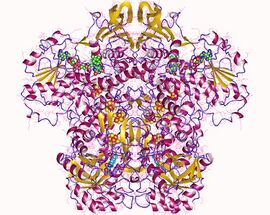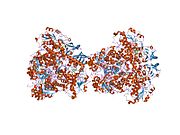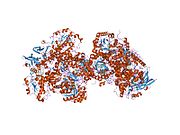Biology:Dihydropyrimidine dehydrogenase (NADP+)
| dihydropyrimidine dehydrogenase (NADP+) | |||||||||
|---|---|---|---|---|---|---|---|---|---|
 Dihydroprymidine dehydrogenase dimer, Sus scrofa | |||||||||
| Identifiers | |||||||||
| EC number | 1.3.1.2 | ||||||||
| CAS number | 9029-01-0 | ||||||||
| Alt. names | Dihydrothymine dehydrogenase | ||||||||
| Databases | |||||||||
| IntEnz | IntEnz view | ||||||||
| BRENDA | BRENDA entry | ||||||||
| ExPASy | NiceZyme view | ||||||||
| KEGG | KEGG entry | ||||||||
| MetaCyc | metabolic pathway | ||||||||
| PRIAM | profile | ||||||||
| PDB structures | RCSB PDB PDBe PDBsum | ||||||||
| Gene Ontology | AmiGO / QuickGO | ||||||||
| |||||||||
In enzymology, a dihydropyrimidine dehydrogenase (NADP+) (EC 1.3.1.2) is an enzyme that catalyzes the chemical reaction
- 5,6-dihydrouracil + NADP+ [math]\displaystyle{ \rightleftharpoons }[/math] uracil + NADPH + H+
Thus, the two substrates of this enzyme are 5,6-dihydrouracil and NADP+, whereas its 3 products are uracil, NADPH, and H+.
In humans the enzyme is encoded by the DPYD gene.[1][2] It is the initial and rate-limiting step in pyrimidine catabolism.[citation needed] It catalyzes the reduction of uracil and thymine.[3] It is also involved in the degradation of the chemotherapeutic drugs 5-fluorouracil and tegafur.[4] It also participates in beta-alanine metabolism and pantothenate and coa biosynthesis.
Terminology
The systematic name of this enzyme class is 5,6-dihydrouracil:NADP+ 5-oxidoreductase.
Other names in common use include:
- dihydrothymine dehydrogenase
- dihydrouracil dehydrogenase (NADP+)
- 4,5-dihydrothymine: oxidoreductase
- DPD
- DHPDH
- dehydrogenase, dihydrouracil (nicotinamide adenine dinucleotide, phosphate)
- DHU dehydrogenase
- hydropyrimidine dehydrogenase
- dihydropyrimidine dehydrogenase (NADP+)
Structural studies
As of late 2007, 5 structures have been solved for this class of enzymes, with PDB accession codes 1GT8, 1GTE, 1GTH, 1H7W, and 1H7X.
Function
The protein is a pyrimidine catabolic enzyme and the initial and rate-limiting factor in the pathway of uracil and thymidine catabolism. Genetic deficiency of this enzyme results in an error in pyrimidine metabolism associated with thymine-uraciluria and an increased risk of toxicity in cancer patients receiving 5-fluorouracil chemotherapy.[2]
Interactive pathway map
See also
- Dihydropyrimidine dehydrogenase deficiency, a genetic disorder
- Cancer pharmacogenomics
References
- ↑ "Assignment of the human dihydropyrimidine dehydrogenase gene (DPYD) to chromosome region 1p22 by fluorescence in situ hybridization". Genomics 24 (3): 613–4. December 1994. doi:10.1006/geno.1994.1680. PMID 7713523. https://zenodo.org/record/1229642.
- ↑ 2.0 2.1 "Entrez Gene: DPYD dihydropyrimidine dehydrogenase". https://www.ncbi.nlm.nih.gov/sites/entrez?Db=gene&Cmd=ShowDetailView&TermToSearch=1806.
- ↑ "Dihydropyrimidine Dehydrogenase Is a Prognostic Marker for Mesenchymal Stem Cell-Mediated Cytosine Deaminase Gene and 5-Fluorocytosine Prodrug Therapy for the Treatment of Recurrent Gliomas". Theranostics 6 (10): 1477–90. 2016. doi:10.7150/thno.14158. PMID 27446484.
- ↑ "Clinical Pharmacogenetics Implementation Consortium guidelines for dihydropyrimidine dehydrogenase genotype and fluoropyrimidine dosing". Clinical Pharmacology and Therapeutics 94 (6): 640–5. December 2013. doi:10.1038/clpt.2013.172. PMID 23988873.
Further reading
- "Oral fluoropoyrimidines". Seminars in Oncology 26 (6): 640–6. December 1999. PMID 10606257.
- "Impact of dihydropyrimidine dehydrogenase on 5-fluorouracil treatment in cancer patients". European Journal of Medical Research 8 (5): 226–8. May 2003. PMID 12844478.
- "Clinical implications of dihydropyrimidine dehydrogenase (DPD) activity in 5-FU-based chemotherapy: mutations in the DPD gene, and DPD inhibitory fluoropyrimidines". International Journal of Clinical Oncology 8 (3): 132–8. June 2003. doi:10.1007/s10147-003-0330-z. PMID 12851836.
- "Cancer pharmacogenomics: powerful tools in cancer chemotherapy and drug development". The Oncologist 10 (2): 104–11. February 2005. doi:10.1634/theoncologist.10-2-104. PMID 15709212.
- "Purification and characterization of dihydropyrimidine dehydrogenase from human liver". The Journal of Biological Chemistry 267 (24): 17102–9. August 1992. doi:10.1016/S0021-9258(18)41899-6. PMID 1512248.
- "Mechanism-based inactivation of dihydropyrimidine dehydrogenase by 5-ethynyluracil". The Journal of Biological Chemistry 267 (8): 5236–42. March 1992. doi:10.1016/S0021-9258(18)42757-3. PMID 1544906.
- "A homologue of a nuclear-coded iron-sulfur protein subunit of bovine mitochondrial complex I is encoded in chloroplast genomes". Biochemistry 30 (11): 2954–60. March 1991. doi:10.1021/bi00225a032. PMID 1901022.
- "Rubredoxin reductase of Pseudomonas oleovorans. Structural relationship to other flavoprotein oxidoreductases based on one NAD and two FAD fingerprints". Journal of Molecular Biology 212 (1): 135–42. March 1990. doi:10.1016/0022-2836(90)90310-I. PMID 2319593.
- "Dihydropyrimidine dehydrogenase activity in human blood mononuclear cells". Enzyme 42 (1): 15–24. 1989. doi:10.1159/000469002. PMID 2528450.
- "Familial deficiency of dihydropyrimidine dehydrogenase. Biochemical basis for familial pyrimidinemia and severe 5-fluorouracil-induced toxicity". The Journal of Clinical Investigation 81 (1): 47–51. January 1988. doi:10.1172/JCI113308. PMID 3335642.
- "cDNA cloning and chromosome mapping of human dihydropyrimidine dehydrogenase, an enzyme associated with 5-fluorouracil toxicity and congenital thymine uraciluria". The Journal of Biological Chemistry 269 (37): 23192–6. September 1994. doi:10.1016/S0021-9258(17)31638-1. PMID 8083224.
- "Dihydropyrimidine dehydrogenase activity in human peripheral blood mononuclear cells and liver: population characteristics, newly identified deficient patients, and clinical implication in 5-fluorouracil chemotherapy". Cancer Research 53 (22): 5433–8. November 1993. PMID 8221682.
- "A point mutation in an invariant splice donor site leads to exon skipping in two unrelated Dutch patients with dihydropyrimidine dehydrogenase deficiency". Journal of Inherited Metabolic Disease 19 (5): 645–54. 1997. doi:10.1007/BF01799841. PMID 8892022.
- "Structural organization of the human dihydropyrimidine dehydrogenase gene". Cancer Research 57 (9): 1660–3. May 1997. PMID 9135003.
- "Lack of correlation between phenotype and genotype for the polymorphically expressed dihydropyrimidine dehydrogenase in a family of Pakistani origin". Pharmacogenetics 7 (2): 161–3. April 1997. doi:10.1097/00008571-199704000-00012. PMID 9170156.
- "Identification of novel point mutations in the dihydropyrimidine dehydrogenase gene". Journal of Inherited Metabolic Disease 20 (3): 335–8. July 1997. doi:10.1023/A:1005357307122. PMID 9266349. https://pure.uva.nl/ws/files/3438628/3234_29940y.pdf.
- "Dihydropyrimidine dehydrogenase (DPD) deficiency: identification and expression of missense mutations C29R, R886H and R235W". Human Genetics 101 (3): 333–8. December 1997. doi:10.1007/s004390050637. PMID 9439663. http://dare.uva.nl/personal/pure/en/publications/dihydropyrimidine-dehydrogenase-dpd-deficiency-identification-and-expression-of-missense-mutations-c29r-r886h-and-r235w(abb93ecc-1cf0-4148-83ac-d26acc27d5ef).html.
- "Suicidal inactivation of human dihydropyrimidine dehydrogenase by (E)-5-(2-bromovinyl)uracil derived from the antiviral, sorivudine". Cancer Letters 122 (1–2): 107–13. January 1998. doi:10.1016/S0304-3835(97)00377-7. PMID 9464498.
- FRITZSON P (1960). "Properties and assay of dihydrouracil dehydrogenase of rat liver". J. Biol. Chem. 235 (3): 719–25. doi:10.1016/S0021-9258(19)67929-9. PMID 13825299.
- "Purification and properties of dihydrothymine dehydrogenase from rat liver". J. Biol. Chem. 256 (1): 219–24. 1981. doi:10.1016/S0021-9258(19)70122-7. PMID 7451435.
 |






